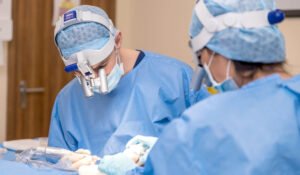What is the hair follicle? It is a complex sac-shaped structure where hair grows. It is found in the outer layer of the skin . Hair follicles are the spaces through which this hair itself grows . That is, in the skin we have very small holes through which the native hair comes out, and these are called follicles. It is made up of a tough protein called keratin and a hair follicle that anchors each hair to the skin. The hair bulb forms the base, and is where living cells divide and grow to build the shaft. Blood vessels feed the cells of the bulb and supply hormones that modify growth and structure at different times in life. These extend from the epidermis to the dermis, slightly entering the hypodermis , which is a fatty layer just under the skin. Their formation occurs during embryogenesis . It depends on a series of signals sent between dermal cells and superficial epithelial cells, which cause fate changes in both cell populations. This causes the differentiation of the shaft, root sheaths and dermal papilla. When hair becomes weak, does not grow, or falls out, the problem is usually in the hair follicles. Our good hair health depends, to a large extent, on its good condition . With age, the follicle contracts, generating increasingly finer and shorter hair, until there reaches a point where no new hair is produced and the follicle even dies and scars. In these cases, the only option to show off again is a hair transplant.
Weak follicles treatment options
If we are in that first phase in which we notice that the hair is weakening and beginning to fall out, we can opt for treatments against alopecia such as ,Minoxidil, a vasodilator that stimulates the follicles, providing a greater amount of blood. This delays shedding and regrowth occurs. In addition, there is the option of a treatment with ,Dutasteride, an antiandrogen that has been proven effective against hair loss, since it prevents hair from losing quality due to the action of male hormones.
Hair follicle anatomy
In this complex structure that makes up the hair root, whose stem grows towards the epidermis and which is the follicle, we distinguish the following parts:
• Hair bulb : It is inserted in the deepest part of the dermis, and is the hair germ. In hair bulb we find the components responsible for nutrition.
• Sebaceous glands . Their job is to lubricate and protect the shaft with the grease they continually produce. They are stimulated by androgens and inhibited by estrogens.
• Erector pili muscle . Also called piloerector, it is a small, involuntary, smooth-fiber muscle that passes through the dermis. It ensures that the hair grows perpendicular to the skin and not attached to it, like hair.
• Pods. We find the external one, which surrounds the follicle, and the internal one, which separates the shaft from the external sheath. In addition, there are also dermal pe in the outermost layer of the superficial dermis. A vascular plexus is located in it that is responsible for transporting oxygen and nutrients through different capillaries. This ensures that the hair grows correctly.
Hair follicle cycle
The hair follicle growth cycle has three phases in which periods of growth (anagen) alternate with periods of loss (telogen). The transition from one to the other is known as the catagen phase.
• Anagen phase
The active phase is known as anagen phase . Hair root cells divide rapidly. New hair forms, pushing hair that has stopped growing or is no longer in the anagen phase, up the follicle and eventually outward. During this phase, hair grows approximately 1 cm every 28 days.
Catagen phase
The catagen phase is also known as transitional stage . The life of this phase is between two and three weeks. Growth stops at catagen phase and the outer root sheath shrinks and sticks to the hair root.
Telogen phase
It is the resting phase and usually represents between 6% and 8% of all hair. During telogen phase, the hair follicle is completely at rest and the hair is fully formed.
How to strengthen the hair follicle?
Although there is no way to avoid genetic and age-related factors, there are routines that can be incorporated into your daily life to keep your hair in the anagen (active) phase for as long as possible. These are some of the best routines that we can consider that strengthen the hair follicle:
Massage your scalp:
By incorporating regular scalp massages into your routine you can help healthy growth, stimulate the bulbs that nourish the strands, and promote the overall health of the roots. Scalp massages can improve thickness and growth, but they are also great for relieving stress and tension. You can use just your hands or choose a hair oil to complement this routine.
Avoid chemical treatments:
Dying your dark hair gray may seem like a great idea for a makeover, but too strong a chemical treatment definitely does not help natural growth or follicle care . In addition chemical treatments weakens. If you want your hair to exists for a long time try to avoid aggressive treatments.
Avoid heat:
Styling tools with high temperatures damage your shaft , causing it to break and frizz. If you can’t give up this habit, at least try to lower the temperature and apply a heat protectant first.
Rinse with cold water:
High temperatures are just as damaging to your shaft as they are to your skin, so whenever possible rinse with cold water to help seal the cuticle and strengthen it before styling.
People also search


